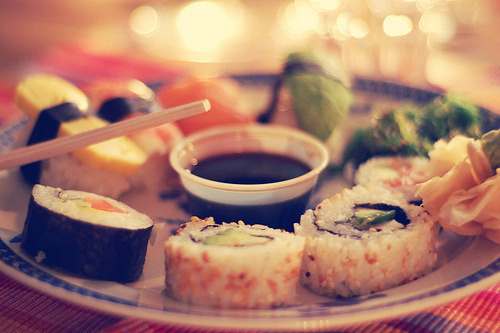While many restaurants are pretty respectful of food allergies and special diets, most have yet to fully grasp the back-to-basics trend. Or at least that’s what I found as I ventured out of my kitchen with this month’sOne Small Change experiment and tried eating clean in suburban Middle America.
Although bigger restaurants and fast-food chains are generally forthcoming with nutrition and ingredient information, it’s at the mom-and-pop eateries where things get more challenging. That’s where you run into guys like Vito who can be, well, a bit dense and understandably protective of their recipes.
To help me digest my experiences, I enlisted the help of Danielle LaFata, M.A., R.D., an Athletes’ Performance nutrition specialist and John Berardi, Ph.D., an expert on human performance and nutrition in St. Catharines, Ontario. Together, we devised some guidelines for eating clean while eating out:
1. Believe it’s possible.
Don’t assume that just because you’re leaving home you’ll have to relax your nutrition plan. Berardi points out that Olympic and pro athletes are on the road all the time. “Consider pro bike riders,” he says. “One day they’re waking up in France to strong coffee and chocolate-filled croissants, and the next day they’re in Germany sitting down for dinner at a place that serves pork and kraut.” The answer is planning and always being mindful of what you’re eating.
2. Pack (or ship) when traveling.
Before he goes on a trip, Berardi researches the hotel and area where he’ll be staying. If healthful eating choices are limited, he’ll ship a carton of food ahead in an insulated container. Similarly, when LaFata is hustling through airports, she’ll carry trail mix, peanut-butter crackers, apples, oranges, a sandwich, or Lara or Trio bars so she’s not tempted by Tito’s Terminal Tacos.
3. Research your restaurant.
Instead of waiting until you sit down at the place where you made reservations and hoping there will be something appealing on the menu, go online and scan the offerings ahead of time. If you have questions or requests, call and ask for the manager or chef.
4. Keep it simple.
Grilled chicken, steamed fish, salad…these have been the old standbys for dieters, and they remain so for clean eaters. The simpler the food, the more unprocessed it is. That’s it.
5. Create your own entrée.
Despite how it appears at most restaurants, you’re not limited to how things are organized and offered on the menu. For instance, you can order the halibut but tell them to replace the cheese sauce with the mango salsa that’s on the nachos. And if broccoli accompanies the prime rib, you can order some of it even though it’s not listed as a separate side dish. The point is if the ingredients are already in the kitchen, the chef should be willing to combine them in more healthful ways. Likewise, don’t be shy about ordering an entrée portion of an appetizer or even a side that better fits your dietary needs.
6. Win them to your cause.
If the waiter scoffs, LaFata recommends telling him you’re training for a fitness competition. This is usually easier to understand and respect than saying something like, “I’m attempting to eat more unprocessed foodstuffs, my good man.” (Just be sure you look like you’re training for an event.)
7. Order this.
When fast-food is your only option, LaFata recommends these relatively unprocessed choices:
Wendy’s: Order a dry baked potato with chives and broccoli, plus a side salad (no dressing). To spice up the latter, fork on some mandarin orange segments, which are sold as a dessert. Although nutritionists often recommend the chili as a more healthful alternative, it actually has about 40 different ingredients.
McDonald’s: About the only things that are clean here are the side salad (sans dressing), Apple Dippers (without the dip) and orange juice. Notice we didn’t recommend the grilled chicken breast filet. That bad boy has about 26 different ingredients, and the liquid margarine in which it’s prepared has about a dozen more. That's one instance when simple isn't so simple.
Pizzerias: My experience at Vito’s notwithstanding, it’s generally cleaner to eat at a local pizzeria than a chain. Or better yet, buy the dough from Vito (it’s cheap) and make your own pie. But better days may be coming. The Kraft Group just invested in a New Orleans establishment called Naked Pizza and plans to franchise its natural pie throughout the country.
Chinese: The mainstay here is brown rice and steamed veggies sprinkled with some light soy sauce.
Sushi: Order the sashimi or nigiri. In general, the fancier the roll’s name (Las Vegas, Wonderful, Godzilla) or the higher its price the more sauces and stuff it’ll have in it.
Mexican: Instead of beef, which is usually lower quality and heavily seasoned, order chicken, fish or bean tacos. The shell should always be soft, not fried, and ideally homemade from corn or flour.
So there you have it. Eating clean when you're eating out isn't as easy as ordering off the big board at some drive-thru, but isn’t that how we got into this predicament in the first place? We stopped thinking about our food. It’s time to start burning some calories being more mindful.
Source
http://www.coreperformance.com/daily/one-small-change/7-rules-for-eating-clean-when-you-eat-out.html






No comments:
Post a Comment